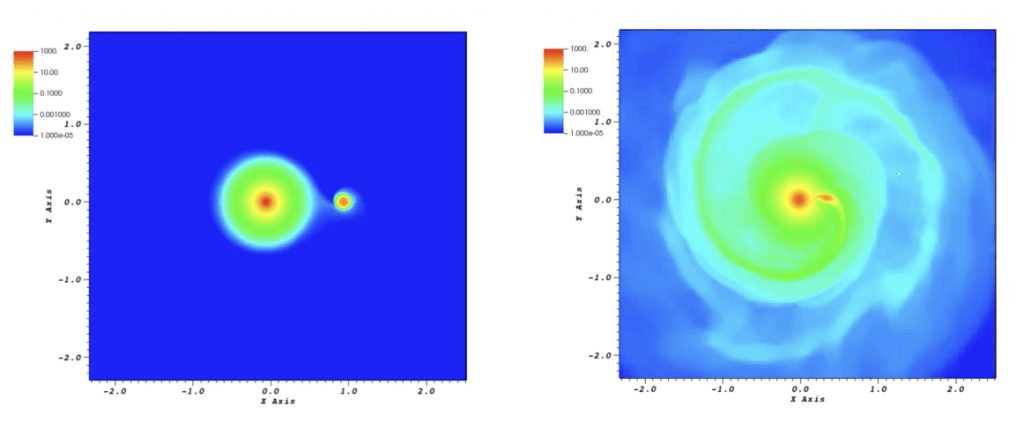Modern humans—or Homo Sapiens—have only been around for about 250,000 years. That’s only the blink of an eye in cosmological terms. As it turns out, the star Betelgeuse may only be about the same age.
A new study explores the idea that Betelgeuse formed from a merger of two stars only a few hundred thousand years ago.
The study is titled “Is Betelgeuse the Outcome of a Past Merger?” The lead author is Manos Chatzopoulos, an Assistant Professor of Physics and Astronomy at Louisiana State University. The study is available on the online open archive arXiv.org.
Betelgeuse, or Alpha Orionis, is the tenth-brightest star in the sky. In northern latitudes it’s prominent during the winter in the constellation Orion. It’s a red supergiant star, and its red color is clearly seen with the naked eye.

Betelgeuse captured headlines earlier this year because of its changing luminosity. The changing luminosity was mysterious, and some wondered if it meant the star would go supernova soon. But there’s more mystery to Betelgeuse than its luminosity variations.
Betelgeuse is probably a run-away star, having been ejected from its birthplace, the Orion OB1 Association. It’s moving through the Interstellar Medium (ISM) at about 30 km/sec., and it creates a massive bow shock that’s over four light years wide. That’s where Betelgeuses’ stellar wind crashes into the ISM.
Betelgeuse also rotates very rapidly, with a rotational velocity of about 5.5 km/second, compared to our Sun at just under 2 km/second. And it’s huge. If it was in center of our Solar System, its orbit would engulf Mercury, Venus, Earth, Mars, and maybe even Jupiter.
In the introduction to their paper, the authors write, “We argue that the best scenario that can explain both the fast rotation of Betelgeuse and its observed large space velocity is one where a binary was dynamically ejected by its parent cluster a few million years ago and then subsequently merged.”
Betelgeuse takes up a lot of space. Red Supergiants like it are the most voluminous stars in the Universe, having burned most of the hydrogen in their core and expanded. Physics dictates that as objects expand, their rotation slows. This is sometimes called the “figure-skater” effect, because as figure skaters spin, they spread their arms to slow their rotation. (But it’s really just conservation of angular momentum.)
But Betelgeuse is rotating more rapidly than it should. In fact it’s not just Betelgeuse that spins faster than it should. Some other stars like it do, too. The authors write: “Recent observational surveys of massive main–
sequence stars have shown that a large number of them rotate rapidly with some reaching rotational speeds as high as ? 450 km s?1.” They also point out that Kepler found stars in their giant phase that rotate as much as 18 times faster than the Sun.
This brings up another observational fact about stars: many of them are in binary pairs. According to Chatzopoulos and the other authors of the paper, this means that mergers might play a larger role in forming stars like Betelgeuse than astronomers might have thought.
“These findings, coupled with the obsevation that the majority (? 60%) of massive stars are members of binary stellar systems, and that most of the massive stars in such systems will at sometime undergo binary interactions with a third of them even experiencing a merger, indicate the importance of studying the effects of stellar mergers on the long–term evolution of the rotational properties of massive stars.”
Here’s what the team of astronomers think happened.
Some time in the past, likely a few million years ago, Betelgeuse and its binary companion were ejected from their birthplace in the Orion OB1 Association. The primary star was about 16 solar masses, and the secondary one was about 2 or 3 solar masses.
As the larger star left the main sequence and evolved into its Red Supergiant phase, its envelope expanded. Eventually, the larger star’s envelope expanded to between 200 and 300 solar radii, and the larger star enveloped the smaller star. Then the speed of the new star and its huge envelope was “spun–up to values which remain in a range consistent with the Betelgeuse observations for thousands of years of evolution.”

Interestingly, the death spiral of the secondary star happened quickly, according to the modelling in the study. “Within ? 175 orbits the secondary came into contact with the primary and subsequently experienced
an inspiral toward the He core of the primary until it got tidally disrupted. This latter phase lasted ? 5 days…”
Betelgeuse also has an unusually high amount of nitrogen in its atmosphere. According to the researchers, that can also be explained by the merger. As the companion star was consumed, it could’ve stirred up nitrogen from the larger star’s core.
In the conclusion of their paper the team writes that stellar mergers are “a prevalent feature in the Universe” and that they’re “a reasonable formation channel for rapidly–rotating giant and supergiant stars…”
But they also acknowledge that there’s another possibility to explain rapidly-rotating red supergiants like Betelgeuse.
“An alternative scenario in which the progenitor of Betelgeuse was spun up by accretion in a binary and released by the supernova explosion of the companion requires a finely tuned set of conditions but cannot be ruled out.”
More:
- Research Paper: IS BETELGEUSE THE OUTCOME OF A PAST MERGER?
- Universe Today: Amazing New Views of Betelgeuse Courtesy of ALMA
- Universe Today video: Betelgeuse Is Still Dimming! And We Have the Pictures to Prove It

